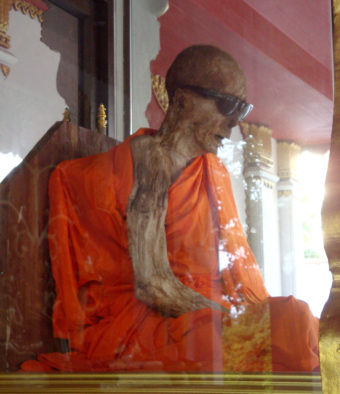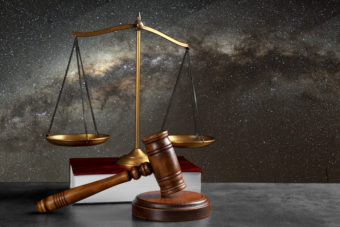Nohomers asks: Can police officers actually commandeer your vehicle like in movies?
 Inevitably in any film that has some member of law enforcement as the protagonist at some point said individual will wave their badge, and potentially their gun, at a passing car and demand to commandeer the vehicle. But if you’re ever driving along and some police officer does this, are you actually under any obligation to give up your car to them?
Inevitably in any film that has some member of law enforcement as the protagonist at some point said individual will wave their badge, and potentially their gun, at a passing car and demand to commandeer the vehicle. But if you’re ever driving along and some police officer does this, are you actually under any obligation to give up your car to them?
Well, somewhat surprisingly, if you live in many parts of the Western world, particularly most states in the United States, Canada, and in the UK- yes.
This is apparently not just surprising to us, but we read examples from a handful of cops who seemed ignorant of the fact that they could do this, despite the law being quite clear in said regions, and a number of notable court cases backing up the right. And further even backing up the right to demand citizens’ aid in the pursuit of a criminal, even if it puts said citizen in mortal danger.
Going back to property, something that also comes as a bit of a surprise, if said officers damage your vehicle or property while they are using it, or if they even demand you come along to drive them and you get injured, even critically, at least in the United States there’s pretty good legal precedent that you will not be compensated for it. So why are police allowed to do this and does this actually happen very often in real life? And what exactly happens if you refuse?
To begin with, we’ll look at how often this actually happens in real life- while we certainly were able to locate many examples of police officers doing this, it would seem the consensus among most officers is that this is almost never done. As Officer Lee Sands of the LA Police Department states, “I have been around for 23 years and I have never heard where we have had to commandeer a car.”
The problem isn’t so much that they aren’t allowed, but rather that some officers and departments still worry about the liability issue, even though the courts seems to nearly always side with the officers of the law on this one. That said, there is the risk of a judge deciding to buck the trend in a given exact set of circumstances for reasons we’ll get into shortly.
Another reason officers don’t exactly go to commandeering vehicles as their first choice is outlined by officer Jackie Bezart of the Long Beach Police Department: “There are so many things that could go wrong. What is the condition of the car? Is there gas in it?” As an example, we found one instance of an officer commandeering a bicycle only to discover as he chased a criminal that the bike’s brakes didn’t work when he tried to use them… He did not mention how that turned out.
On top of that, many officers we read expressed their concern over injury to citizens and potential damage to their property, not so much for legal liability issues, but just moral ones, not wanting to involve bystanders if they can help it.
And on top of all of that, perhaps the biggest reason of all as to why this isn’t generally done is simply that the vast majority of time with modern law enforcement agencies, there just isn’t a need.
But that doesn’t mean it doesn’t happen. For example, in 2005 Sheriff Chuck Dunn needed a plane and so called up a local airport and commandeered a Cessna 150 airplane from its owner, Mike Spicer. Spicer was happy to cooperate, and brought along for the flight the mayor of Morganville, Arnie Knoettgen, who was also a reserve deputy.
The pair flew around looking for one Michael Michaud who had fled in his truck after being pulled over and an issue with the truck’s registration was discovered. They soon found the truck and then Michaud lying in thick foliage apparently trying to hide, but was fully visible from the air. Unfortunately for Spicer, as he began to circle above, Michaud pulled out his gun and fired on the plane.
Probably more dumb luck than anything, Michaud was able to shoot Spicer in the head from over a hundred yards away.
While you might think surely this then ended fatally for both Spicer and Deputy Knoettgen, the latter of which not knowing how to fly a plane, in this case, while the bullet struck Spicer’s forehead just above his left eye and he did require a couple hour surgery later, there was apparently no serious damage done.
He later stated, “I knew I had been hit in the head, but I couldn’t feel anything… That’s what really scared me…” As the blood was gushing, he then states he was comforted by the fact that at least he’d get to see his long deceased child soon. But then, “I realized I had to get Arnie back… That kind of brought me back to reality.”
He immediately turned the plane back towards the airport to hopefully land before Spicer passed out. While flying back, he also attempted to teach Knoettgen how to fly and land a plane, just in case. (And if you’re wondering, see our video: Has Any Passenger Ever Successfully Landed an Airplane When Something Happens to the Pilot?)
Once they started their decent to land, Spicer cinched up his seat belt as tight as possible to try to make it so if he passed out during the landing he didn’t slump over on the controls, but then otherwise made a perfectly routine landing.
In a mildly humorous example of a police officer commandeering a vehicle, one Officer Stephen Sanford was urinating on the side of the road when a car sped by and his partner in the police car decided to leave him there with his pants partially down and go give a ticket. A little later, Officer Sanford states,
I heard the alert tone of an officer in danger activate over my radio. I couldn’t see the stop, as dick head [his partner] was over a hill and out of my view. I pulled out my flashlight and waved down the first pair of headlights I saw coming. It was a truck driver. I yelled “Take me down the road, my partner’s in trouble” Dispatch had been screaming at him over the radio, but he wasn’t answering. Man, that truck driver put his best into it, and a mile or so later later, I jumped down, (I hung on the outside of the truck for the ride, cause I’m awesome…) and ran to help the dick head. (Truck driver pulled the semi across two lanes of highway to keep traffic stopped while I figured things out…)
At this point, I was kind of hoping he was getting his ass beat, I was going to help (beat his ass…). He wasn’t. He had accidentally hit the emergency button, and had the volume all the way down on his radio… I canceled the scores of police cars from all across the county burning up tires to help us. I waved the truck driver off, and kicked dickhead out of the driver’s seat. I spent the next two hours… berating him for leaving his partner.
In yet another mildly humorous case, in 2014 in New York city two officers arrested a man, Bryan McMenamin, cuffed him, and put him in the back seat of their vehicle. At a certain point they made a stop off at some location for undisclosed reasons and both officers exited the vehicle… at which point McMenamin managed to get himself into the drivers seat, which apparently still had the keys, and drove off, leaving the officers behind.
One of the officers was injured when he attempted to get back in the car before it sped off, but the other flagged down a Hyundai Sonata and demanded the woman in it give him the car. The problem was, the officer was in plain clothes and at the time had his gun out, leading the woman to believe he was trying to steal her car.
You might think the fact that she thought him a criminal and he had a gun might have induced her to give up the car immediately anyway, but instead she refused. Once the officer pulled out his badge, however, despite that such badges are easy to counterfeit to the extent needed to fool a random citizen, she was satisfied and let him take it. When he returned the car to her, it was damaged and he had been unsuccessful in the chase.
Modern examples out of the way, how did this legal right of officers to commandeer things start? Going back to Merry Ol’ England, what is now commonly referred to as posse comitatus (“the power of the county”) has been common law for many centuries in England and was essentially meant as a way for law enforcement to be able to legally drum up help and equipment as needed.
As described by Judge Jon C. Blue who was involved in the Connecticut Supreme Court case State v. Floyd in which three defendants were being tried for failure to assist a police officer when that aid was demanded by said officer,
The antecedents … are centuries old. Their origins lie not in the urban landscape of present-day America but in the forests and walled cities of medieval England. Long before the creation of organized police forces, the common-law process of apprehending suspected felons was the hue and cry. The person discovering a felony would raise a cry of “Out! Out!” prompting the neighbors to turn out with their bows, arrows, and knives. The “hue” would be passed by horn-blowing from town to town until the ad hoc posse caught the malefactor or gave up the chase. Any malefactor overtaken would receive summary justice.
This was codified in the 1275 First Statute of Westminster which states, “That all generally be ready and appareled, at the Commandment and Summons of Sheriffs, and at the Cry of the Country, to sue and arrest felons, when any need is … and they that will not do so … shall make a grievous fine to the King.”
Later, in the 1887 Sheriffs Act, it states in Section 8:
Every person in a county shall be ready and apparelled at the command of the sheriff and at the cry of the country to arrest a felon whether within a franchise or without, and in default shall on conviction be liable to a fine, and if default be found in the lord of the franchise he shall forfeit the franchise to the Queen, and if in the bailiff he shall be liable besides the fine to imprisonment for not more than one year, or if he have not whereof to pay the fine, than two years.
Jumping back across the pond to the rebels that dared besmirch the King’s good name in the late 18th century, this legal authority of police to drum up a posse or commandeer people’s horses, wagons, houses, guns, whatever, remained a perfectly justified right they had adopted from England. This was particularly handy as the rapidly expanding nation of former terrorists and their descendants claimed the wider land for their own, with law enforcement across the new realm often being woefully understaffed and under equipped to keep the peace.
In fact, for a time, law enforcement could even require local military personnel to assist them as needed until 1878 with the passing of the Posse Comitatus Act in the United States, which in the current version states in part: “Whoever, except in cases and under circumstances expressly authorized by the Constitution or Act of Congress, willfully uses any part of the Army or the Air Force as a posse comitatus or otherwise to execute the laws shall be fined under this title or imprisoned not more than two years, or both.”
Not strictly about stopping Sheriffs from commandeering military equipment or personnel, the main point was more about reducing the power of the government to use the military for law enforcement purposes.
As for specific laws in modern times, while they vary from place to place, in the UK, for example, while the aforementioned 1887 Sheriffs Act was repealed by the Criminal Law Act of 1967, this remains one of the few common law offences still enforced and there are no limits we could find on the length of imprisonment or fine that can be leveled for refusal, with this being decided on a case by case basis. However, as you might imagine, this is extremely rarely prosecuted in modern times, and even when it is, usually a small fine is the worst of it for the person who refused to comply.
Jumping across the pond, in Canada, the Canadian Criminal Code includes this gem:
Every one who… omits, without reasonable excuse, to assist a public officer or peace officer in the execution of his duty in arresting a person or in preserving the peace, after having reasonable notice that he is required to do so, or resists or willfully obstructs any person in the lawful execution of a process… is guilty of an indictable offence and is liable to imprisonment for a term not exceeding two years, or an offence punishable on summary conviction.
In the U.S., the law varies from state to state, and even sometimes within regions in said states, but in the vast majority of states it is required that citizens comply when an officer demands their property or aid when a pressing need is present.
That said, there is an out in some cases. For example, in Alabama, while they do require citizens to aid the police when that is commanded by the officer, it does note, “A person is not liable under this section if the failure or refusal to aid the officer was reasonable under the circumstances. The burden of injecting this issue is on the defendant, but this does not shift the burden of proof.” Given what constitutes “reasonable” is very much open to interpretation, this leaves a bit of legal wiggle room, especially if one has a particularly good lawyer.
Noteworthy here, Alabama doesn’t seem to stipulate any age restrictions, so the whole “reasonable” stipulation also gets a toddler out of complying should an officer demand the aid of your little princess in nabbing the bad guy. For the record, most states and countries we looked at stipulate the person needs to be an adult to be required to comply with the request, with 18 usually the age cutoff.
Similarly, while in Colorado the officers do still have this legal ability, in 1999 then Colorado attorney general outlined very specifically why there is still potentially a liability issue a given officer might not want to deal with. He states,
To do so … the sheriff would have to demonstrate that he could not have “fully performed” his peace keeping functions in that situation without the use of that action, and therefore, his power to act was implied. The sheriff would have to justify his actions based on the facts of each situation, and after the actions have occurred. Therefore, the sheriff is taking a legal risk when relying on a later justification of implied powers. By contrast, the use of traditional arrest powers is more appropriate and well defined.
On top of that, on the citizen refusal part, most of the laws regarding this specifically note that the officer must “demand” compliance, potentially giving another out if the officer worded it in the form of a request, such as “Can I use this vehicle to chase down a criminal?” The person in question in many jurisdictions could legally refuse that request, but not if the officer said something like, “I am commandeering your vehicle for official police use. Get out.”
We should also probably mention that “mortal danger” is not considered a valid reason to refuse the request, with a handful of court cases in the last century or so seeming to back this up. One of the most cited cases, even in modern law where this rarely comes up, occurred in the late 19th century in the United States, when a shop owner in Alabama refused to aid an officer in an arrest because of the inherent danger in that instance. Said shop owner was ultimately prosecuted for this, with the court noting, “The fact that there is danger involved is the very thing which calls for and makes obedience a duty.”
And if you’re wondering what happens to you if you do refuse, as alluded to in the UK example, generally you’ll be subjected to some sort of fine, in most places in the U.S. ranging from a small slap on the wrist type fine in the $50-$100 range, to in some cases as much as a few thousand dollars. Jail time is also a possibility in some regions, but we’re guessing it would take a pretty extreme case for a judge to level that against someone, and at least in modern times we couldn’t find any examples of a judge doing this.
Moving on to the lack of compensation or liability by police departments, while exact laws vary, in most cases the authorities are not obligated to give you any compensation, with a handful of court cases illustrating this. Perhaps most famously, in the 1920s a police officer flagged down a taxi and then demanding the driver of said taxi chase after a fleeing car. The cab driver did just that, only to die shortly thereafter in a car crash. His widow was not compensated for this by the police, and further was denied when she tried to sue the Yellow Taxi Corporation for restitution given that he was technically going about his normal duties at the time, even though it was at the request of the police in this case. The 1928 case, Babbington v Yellow Taxi ultimately went against the widow, with the U.S. court citing British common law as justification, and the judge noting, “The horse has yielded to the motorcar as an instrument of pursuit and flight. … We may be sure that the man who failed to use his horse … would have had to answer to the King.”
That said, there are occasional cases where the court did hold the authorities responsible for damage and required they reimburse, it is just rare. But all is not lost necessarily if this happens to you. Some departments will do their best to compensate people in these cases even if they are not strictly obligated to. On top of that, some departments even have internal rules in place, for example under their department’s worker’s compensation plans, to compensate citizens injured while assisting the police. In these cases, sometimes even giving said individual the exact same benefits an officer would have received in similar circumstances. After all, in such a request they are more or less functioning as temporary officers.
And if you happen to be wondering, as we did, if agencies like the FBI ever commandeered vehicles, we couldn’t find any examples of agents doing this and, seeming to corroborate this, FBI Agent Steve Kodak noted, “I have never heard of anyone doing that in my 16 years with the agency…” That said, presumably there are exceptions somewhere.
Also, interestingly enough, it turns out in some regions, for example Connecticut, firefighters are allowed to commandeer vehicles and property if the need arises over the course of their duties. They are also within their rights to demand aid from citizens, with failure to comply in cases of urgent need once again potentially resulting in a fine or jail time.
But to sum up, yes, it turns out, while extremely rare in modern times, in a lot of places in the world, the police are legally able to commandeer your vehicle like in movies should there be a pressing and immediate need, so long as that immediate need is something a lot more serious than a double glazed doughnut. Unless that double glazed doughnut happens to being carried by a fleeing criminal we suppose. Then it’s basically a win/win/win situation for the officer. Get the bad guy in a badass Hollywood way and get delicious clogged arteries and dad-bod at the same time.
If you liked this article, you might also enjoy our new popular podcast, The BrainFood Show (iTunes, Spotify, Google Play Music, Feed), as well as:
Expand for References










 On the scenic Thai island of Koh Sumai, tucked away in the Wat Khunaram temple is the mummified body of one of Thailand’s most famous monks- Luang Pho Daeng. Remarkably well preserved, Luang Pho Daeng’s body was put on display sometime in the 1970s and is still there today, virtually unchanged from the day he passed away, with the notable exception of a giant pair of Ray-Ban sunglasses that were added later. So how does his body stay so naturally well preserved and why is he wearing Ray-Bans?
On the scenic Thai island of Koh Sumai, tucked away in the Wat Khunaram temple is the mummified body of one of Thailand’s most famous monks- Luang Pho Daeng. Remarkably well preserved, Luang Pho Daeng’s body was put on display sometime in the 1970s and is still there today, virtually unchanged from the day he passed away, with the notable exception of a giant pair of Ray-Ban sunglasses that were added later. So how does his body stay so naturally well preserved and why is he wearing Ray-Bans?
 The Black Samurai, despite sounding like a name that’d be more at home in a movie or a comic book than the real world, is a genuine nickname given to a mysterious man from feudal Japan, otherwise known only as Yasuke.
The Black Samurai, despite sounding like a name that’d be more at home in a movie or a comic book than the real world, is a genuine nickname given to a mysterious man from feudal Japan, otherwise known only as Yasuke.





 While it might seem like something out of science fiction, given that humans are presently in space and soon enough mass space tourism is going to open up the possibility for many, many more, it’s only a matter of time before someone commits a crime in space, with it being alleged the first already occurred in 2019, which we’ll get to shortly. So what exactly happens if someone does break the law in space? Could you, say, commit murder and
While it might seem like something out of science fiction, given that humans are presently in space and soon enough mass space tourism is going to open up the possibility for many, many more, it’s only a matter of time before someone commits a crime in space, with it being alleged the first already occurred in 2019, which we’ll get to shortly. So what exactly happens if someone does break the law in space? Could you, say, commit murder and 




 Inevitably in any film that has some member of law enforcement as the protagonist at some point said individual will wave their badge, and potentially their gun, at a passing car and demand to commandeer the vehicle. But if you’re ever driving along and some police officer does this, are you actually under any obligation to give up your car to them?
Inevitably in any film that has some member of law enforcement as the protagonist at some point said individual will wave their badge, and potentially their gun, at a passing car and demand to commandeer the vehicle. But if you’re ever driving along and some police officer does this, are you actually under any obligation to give up your car to them?